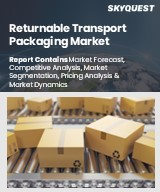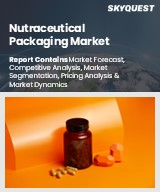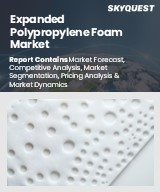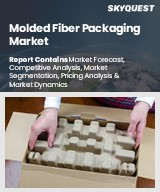
|
시장보고서
상품코드
1700164
세계의 써모콜 포장 시장 : 제품 유형, 소재 유형, 기능성, 용도, 최종 사용자, 지역별 분석 및 예측(-2032년)Thermocol Packaging Market Forecasts to 2032 - Global Analysis By Product Type, Material Type, Functionality, Application, End User and By Geography |
||||||
Stratistics MRC에 따르면 세계의 써모콜 포장 시장은 2025년에 187억 달러를 차지하고 예측 기간 동안 CAGR 8.0%를 나타내며 2032년에는 321억 달러에 이를 것으로 예상됩니다.
써모콜 포장은 발포 폴리스티렌(EPS)을 사용하여 보관, 운송, 취급 중인 제품을 보호, 단열합니다. 이 포장은 적당한 가격으로, 내습성이 있어, 특정의 품목에 맞도록 성형할 수 있습니다.
경량 포장 솔루션에 대한 수요 증가
써모콜 포장은 경제적인 이점이 있기 때문에 비용을 최소화하고자 하는 업계에서는 매우 인기 있는 솔루션이 되고 있습니다. 저렴하고 신뢰성이 높은 포장 솔루션을 제공할 수 있기 때문에 기업으로부터도 지지되고 있습니다. 또한, 소비재, 헬스케어, 식품 가공 등의 분야에 걸친 그 범용성이, 시장 확대의 원동력이 되고 있습니다.
환경에 대한 배려와 비생분해성
단열의 비생분해성이라는 성질은 환경면에서 큰 과제가 되어, 플라스틱 폐기물 관리에 대한 우려가 높아지고 있습니다. EPS 기반 제품에 대한 수요에 영향을 미치고 있습니다. 써모콜 포장 재활용은 여전히 비용이 많이 들고 복잡한 프로세스이기 때문에 기업은 대규모 폐기물 감소 이니셔티브를 도입하는 것을 주저하고 있습니다.
써모콜 포장 제조의 기술적 진보
단열 생산의 지속적인 발전은 환경 친화적인 포장 솔루션에 대한 길을 열고 있습니다.
원유 가격 변동이 원재료에 영향
폴리스티렌의 생산은 석유 유래의 원료에 의존하기 때문에 써모콜 포장 업계는 원유 가격의 변동에 매우 민감합니다. 실성으로 인한 공급망의 혼란은 원재료 조달에 더욱 복잡해지고 있습니다.
COVID-19의 영향 :
COVID-19의 발생은 공급망에 큰 혼란을 가져오고 써모콜 포장 제조업체의 원재료 부족을 초래했습니다. 헬스케어, 특히 온도에 민감한 의료용품의 출하가 증가하여 수요를 더욱 밀어 올렸습니다.
예측 기간 동안 써모콜 포장 상자 부문이 최대가 될 것으로 예상
식품, 의약품, 섬세한 상품의 보존에 폭넓게 사용되고 있기 때문에 써모콜 포장 박스 분야는 예측 기간 중에 최대 시장 점유율을 차지할 것으로 예상됩니다. 의존도가 높아짐에 따라 안전한 포장 솔루션에 대한 수요가 높아지고 서모콜라박스의 채용이 강화되고 있으며, 또한 식품과 의약품공급망에서 제품의 무결성을 유지하는 것이 중시되고 시장 성장을 가속하고 있습니다.
예측 기간 동안 발포 폴리스티렌(EPS) 분야의 CAGR이 가장 높을 것으로 예상
예측 기간 동안 발포 폴리스티렌(EPS) 분야는 합리적인 가격과 포장 용도의 경량성으로 인해 가장 높은 성장률을 보일 것으로 예상됩니다. EPS의 지속적인 개선은 환경 친화적인 포장 솔루션에서 EPS의 역할을 확대하고 있습니다.
최대 점유율을 차지하는 지역
예측기간 동안 아시아태평양은 급속한 산업화와 보호포장 수요 증가에 힘입어 최대 시장 점유율을 차지할 것으로 예상됩니다. 모든 주요 경제국은 생산 및 공급 능력을 확대하는 데 중요한 역할을 하고 있습니다.
CAGR이 가장 높은 지역 :
예측 기간 동안 지속 가능한 써모콜 포장 기술의 발전으로 북미가 가장 높은 CAGR을 나타낼 것으로 예상됩니다. E-Commerce 산업의 활황은 경량이고 내충격성이 있는 포장에 대한 요구를 가속화하고 있습니다.
무료 사용자 지정 오퍼링 :
이 보고서를 구독하는 고객은 다음 무료 맞춤설정 옵션 중 하나를 사용할 수 있습니다.
- 기업 프로파일
- 추가 시장 기업의 종합적 프로파일링(3개사까지)
- 주요 기업의 SWOT 분석(3개사까지)
- 지역 세분화
- 고객의 관심에 응한 주요국 시장 추계·예측·CAGR(주 : 타당성 확인에 따름)
- 경쟁 벤치마킹
- 제품 포트폴리오, 지리적 존재, 전략적 제휴에 기반한 주요 기업 벤치마킹
목차
제1장 주요 요약
제2장 서문
- 개요
- 이해관계자
- 조사 범위
- 조사 방법
- 데이터 마이닝
- 데이터 분석
- 데이터 검증
- 조사 접근
- 조사 자료
- 1차 조사 자료
- 2차 조사 정보원
- 전제조건
제3장 시장 동향 분석
- 성장 촉진요인
- 성장 억제요인
- 기회
- 위협
- 제품분석
- 용도 분석
- 최종 사용자 분석
- 신흥 시장
- COVID-19의 영향
제4장 Porter's Five Forces 분석
- 공급기업의 협상력
- 구매자의 협상력
- 대체품의 위협
- 신규 참가업체의 위협
- 경쟁 기업간 경쟁 관계
제5장 세계의 써모콜 포장 시장 : 제품 유형별
- 써모콜 박스
- 써모콜 시트
- 써모콜 컨테이너
- 써모콜 트레이
- 써모콜 몰드
- 기타 제품 유형
제6장 세계의 써모콜 포장 시장 : 소재 유형별
- 발포 폴리스티렌(EPS)
- 압출 폴리스티렌(XPS)
- 기타 소재 유형
제7장 세계의 써모콜 포장 시장 : 기능별
- 보호 포장
- 써모콜 포장
- 장식용 포장
- 기타 기능
제8장 세계의 써모콜 포장 시장 : 용도별
- 보호 포장
- 단열
- 건설 충진
- 기타 용도
제9장 세계의 써모콜 포장 시장 : 최종 사용자별
- 제조업체
- 물류 및 3PL 제공업체
- 소매업체
- 전자상거래
- 기타 최종 사용자
제10장 세계의 써모콜 포장 시장 : 지역별
- 북미
- 미국
- 캐나다
- 멕시코
- 유럽
- 독일
- 영국
- 이탈리아
- 프랑스
- 스페인
- 기타 유럽
- 아시아태평양
- 일본
- 중국
- 인도
- 호주
- 뉴질랜드
- 한국
- 기타 아시아태평양
- 남미
- 아르헨티나
- 브라질
- 칠레
- 기타 남미
- 중동 및 아프리카
- 사우디아라비아
- 아랍에미리트(UAE)
- 카타르
- 남아프리카
- 기타 중동 및 아프리카
제11장 주요 발전
- 계약, 파트너십, 협업, 합작투자
- 인수와 합병
- 신제품 발매
- 사업 확대
- 기타 주요 전략
제12장 기업 프로파일링
- BASF SE
- Sealed Air Corporation
- Sonoco Products Company
- Synthos SA
- Styropack
- Drew Foam Companies Inc.
- Ineos Styrolution Group GmbH
- Kaneka Corporation
- Alpek SAB de CV
- Nova Chemicals Corporation
- Total SA
- Styron LLC
- SC Johnson & Son Inc.
- Flint Hills Resources LLC
- Sunpor Kunststoff GmbH
- Styrochem
According to Stratistics MRC, the Global Thermocol Packaging Market is accounted for $18.7 billion in 2025 and is expected to reach $32.1 billion by 2032 growing at a CAGR of 8.0% during the forecast period. Thermocol packaging involves using expanded polystyrene (EPS) foam to protect and insulate products during storage, transportation, and handling. Known for being lightweight, durable, and shock-absorbent, it is commonly used to shield delicate items like electronics, glassware, and medical equipment from damage. Its thermal insulation properties make it suitable for temperature-sensitive products such as pharmaceuticals and perishable foods. This packaging is affordable, moisture-resistant, and can be shaped to fit specific items. While it remains popular for its protective features and cost efficiency, concerns about its environmental impact have prompted efforts to enhance recycling methods and develop sustainable alternatives.
Market Dynamics:
Driver:
Rising demand for lightweight packaging solutions
The economic advantage of thermocol packaging makes it a highly sought-after solution for industries aiming to minimize costs. Its lightweight structure plays a crucial role in cutting down logistics expenses, particularly for bulk transportation. Due to its exceptional impact resistance, thermocol ensures the safety of delicate items during transit. Businesses favor it for its ability to provide reliable packaging solutions at an affordable rate. Furthermore, its versatility across sectors such as consumer goods, healthcare, and food processing continues to drive market expansion.
Restraint:
Environmental concerns and non-biodegradability
The non-biodegradable nature of thermocol poses a significant environmental challenge, leading to growing concerns over plastic waste management. Governments worldwide are enforcing strict regulations on plastic usage, creating hurdles for thermocol packaging manufacturers. Consumers are increasingly shifting toward sustainable packaging solutions, impacting the demand for conventional EPS-based products. Recycling thermocol remains a costly and complex process, discouraging companies from integrating large-scale waste reduction initiatives. Moreover, evolving environmental policies across various regions are compelling industries to seek alternative biodegradable packaging materials.
Opportunity:
Technological advancements in thermocol manufacturing
Ongoing advancements in thermocol manufacturing are paving the way for eco-friendly and recyclable packaging solutions. Improved molding techniques have strengthened the durability and functionality of thermocol packaging, enhancing its protective capabilities. The incorporation of biodegradable components is contributing to environmentally responsible packaging alternatives. Additionally, automation in production processes is streamlining operations, leading to cost savings and higher manufacturing efficiency.
Threat:
Volatility in oil prices impacting raw materials
The thermocol packaging industry is highly sensitive to crude oil price variations, as polystyrene production depends on petroleum-derived inputs. Rising oil costs contribute to increased production expenditures, making thermocol packaging less cost-effective. Supply chain disruptions caused by geopolitical uncertainties add further complications to raw material procurement. Maintaining price stability while managing fluctuating input costs presents a challenge for manufacturers hampering the growth of the market.
Covid-19 Impact:
The outbreak of COVID-19 created substantial supply chain disruptions, leading to raw material shortages for thermocol packaging manufacturers. Production delays due to pandemic-related restrictions affected the market's ability to meet rising packaging demands. Increased healthcare shipments, particularly for temperature-sensitive medical supplies, further boosted demand. As the industry recovers, there is a growing emphasis on sustainable alternatives to address environmental concerns in packaging.
The thermocol boxes segment is expected to be the largest during the forecast period
The thermocol boxes segment is expected to account for the largest market share during the forecast period owing to their extensive use in preserving food, pharmaceuticals, and delicate goods. Their superior insulation properties make them essential for transporting perishable items, particularly in medical and seafood logistics. With the increasing reliance on e-commerce, demand for secure packaging solutions has risen, strengthening thermocol box adoption. Furthermore, the growing emphasis on maintaining product integrity in food and pharmaceutical supply chains is fueling market growth.
The expanded polystyrene (EPS) segment is expected to have the highest CAGR during the forecast period
Over the forecast period, the expanded polystyrene (EPS) segment is predicted to witness the highest growth rate driven by its affordability and lightweight nature in packaging applications. It is a preferred choice for safeguarding delicate products, including electronic devices and high-value consumer goods. Continuous improvements in recyclable EPS variants are expanding its role in environmentally conscious packaging solutions. The growing need for effective cold-chain packaging in the food and beverage sector is further fueling EPS adoption.
Region with largest share:
During the forecast period, the Asia Pacific region is expected to hold the largest market share, propelled by the rapid industrialization and increased demand for protective packaging. The thriving e-commerce, electronics, and food packaging sectors are significantly driving thermocol adoption. Major economies like China and India are playing a crucial role in expanding production and supply capabilities. Moreover, a strong logistics and supply chain infrastructure in the region enhances the adoption of thermocol-based packaging solutions.
Region with highest CAGR:
Over the forecast period, the North America region is anticipated to exhibit the highest CAGR, driven by advancements in sustainable thermocol packaging technologies. The region's pharmaceutical and food sectors are witnessing a surge in demand for temperature-controlled packaging solutions. The booming e-commerce industry is accelerating the need for lightweight and impact-resistant packaging. Furthermore, extensive research and development investments are supporting the development of high-performance, eco-friendly packaging solutions.
Key players in the market
Some of the key players in Thermocol Packaging Market include BASF SE, Sealed Air Corporation, Sonoco Products Company, Synthos S.A., Styropack, Drew Foam Companies Inc., Ineos Styrolution Group GmbH, Kaneka Corporation, Alpek SAB de CV, Nova Chemicals Corporation, Total SA, Styron LLC, S C Johnson & Son Inc., Flint Hills Resources LLC, Sunpor Kunststoff GmbH and Styrochem.
Key Developments:
In March 2024, BASF SE introduced a new eco-friendly thermocol packaging solution made from bio-based expanded polystyrene (EPS), aimed at reducing environmental impact while maintaining superior insulation and durability.
In February 2024, Sealed Air Corporation launched an advanced thermocol packaging design with improved shock-absorption technology to enhance product protection in logistics and e-commerce applications.
In January 2024, Kaneka Corporation unveiled a fully recyclable thermocol packaging material, addressing sustainability concerns in food and pharmaceutical packaging sectors while ensuring high thermal insulation properties.
Product Types Covered:
- Thermocol Boxes
- Thermocol Sheets
- Thermocol Containers
- Thermocol Trays
- Thermocol Molds
- Other Product Types
Material Types Covered:
- Expanded Polystyrene (EPS)
- Extruded Polystyrene (XPS)
- Other Material Types
Functionalities Covered:
- Protective Packaging
- Insulated Packaging
- Decorative Packaging
- Other Functionalities
Applications Covered:
- Food & Beverage Packaging
- Thermal Insulation
- Construction Filling
- Other Applications
End Users Covered:
- Manufacturers
- Logistics & 3PL Providers
- Retailers
- E-commerce
- Other End Users
Regions Covered:
- North America
- US
- Canada
- Mexico
- Europe
- Germany
- UK
- Italy
- France
- Spain
- Rest of Europe
- Asia Pacific
- Japan
- China
- India
- Australia
- New Zealand
- South Korea
- Rest of Asia Pacific
- South America
- Argentina
- Brazil
- Chile
- Rest of South America
- Middle East & Africa
- Saudi Arabia
- UAE
- Qatar
- South Africa
- Rest of Middle East & Africa
What our report offers:
- Market share assessments for the regional and country-level segments
- Strategic recommendations for the new entrants
- Covers Market data for the years 2024, 2025, 2026, 2028, and 2032
- Market Trends (Drivers, Constraints, Opportunities, Threats, Challenges, Investment Opportunities, and recommendations)
- Strategic recommendations in key business segments based on the market estimations
- Competitive landscaping mapping the key common trends
- Company profiling with detailed strategies, financials, and recent developments
- Supply chain trends mapping the latest technological advancements
Free Customization Offerings:
All the customers of this report will be entitled to receive one of the following free customization options:
- Company Profiling
- Comprehensive profiling of additional market players (up to 3)
- SWOT Analysis of key players (up to 3)
- Regional Segmentation
- Market estimations, Forecasts and CAGR of any prominent country as per the client's interest (Note: Depends on feasibility check)
- Competitive Benchmarking
- Benchmarking of key players based on product portfolio, geographical presence, and strategic alliances
Table of Contents
1 Executive Summary
2 Preface
- 2.1 Abstract
- 2.2 Stake Holders
- 2.3 Research Scope
- 2.4 Research Methodology
- 2.4.1 Data Mining
- 2.4.2 Data Analysis
- 2.4.3 Data Validation
- 2.4.4 Research Approach
- 2.5 Research Sources
- 2.5.1 Primary Research Sources
- 2.5.2 Secondary Research Sources
- 2.5.3 Assumptions
3 Market Trend Analysis
- 3.1 Introduction
- 3.2 Drivers
- 3.3 Restraints
- 3.4 Opportunities
- 3.5 Threats
- 3.6 Product Analysis
- 3.7 Application Analysis
- 3.8 End User Analysis
- 3.9 Emerging Markets
- 3.10 Impact of Covid-19
4 Porters Five Force Analysis
- 4.1 Bargaining power of suppliers
- 4.2 Bargaining power of buyers
- 4.3 Threat of substitutes
- 4.4 Threat of new entrants
- 4.5 Competitive rivalry
5 Global Thermocol Packaging Market, By Product Type
- 5.1 Introduction
- 5.2 Thermocol Boxes
- 5.3 Thermocol Sheets
- 5.4 Thermocol Containers
- 5.5 Thermocol Trays
- 5.6 Thermocol Molds
- 5.7 Other Product Types
6 Global Thermocol Packaging Market, By Material Type
- 6.1 Introduction
- 6.2 Expanded Polystyrene (EPS)
- 6.3 Extruded Polystyrene (XPS)
- 6.4 Other Material Types
7 Global Thermocol Packaging Market, By Functionality
- 7.1 Introduction
- 7.2 Protective Packaging
- 7.3 Insulated Packaging
- 7.4 Decorative Packaging
- 7.5 Other Functionalities
8 Global Thermocol Packaging Market, By Application
- 8.1 Introduction
- 8.2 Protective Packaging
- 8.3 Thermal Insulation
- 8.4 Construction Filling
- 8.5 Other Applications
9 Global Thermocol Packaging Market, By End User
- 9.1 Introduction
- 9.2 Manufacturers
- 9.3 Logistics & 3PL Providers
- 9.4 Retailers
- 9.5 E-commerce
- 9.6 Other End Users
10 Global Thermocol Packaging Market, By Geography
- 10.1 Introduction
- 10.2 North America
- 10.2.1 US
- 10.2.2 Canada
- 10.2.3 Mexico
- 10.3 Europe
- 10.3.1 Germany
- 10.3.2 UK
- 10.3.3 Italy
- 10.3.4 France
- 10.3.5 Spain
- 10.3.6 Rest of Europe
- 10.4 Asia Pacific
- 10.4.1 Japan
- 10.4.2 China
- 10.4.3 India
- 10.4.4 Australia
- 10.4.5 New Zealand
- 10.4.6 South Korea
- 10.4.7 Rest of Asia Pacific
- 10.5 South America
- 10.5.1 Argentina
- 10.5.2 Brazil
- 10.5.3 Chile
- 10.5.4 Rest of South America
- 10.6 Middle East & Africa
- 10.6.1 Saudi Arabia
- 10.6.2 UAE
- 10.6.3 Qatar
- 10.6.4 South Africa
- 10.6.5 Rest of Middle East & Africa
11 Key Developments
- 11.1 Agreements, Partnerships, Collaborations and Joint Ventures
- 11.2 Acquisitions & Mergers
- 11.3 New Product Launch
- 11.4 Expansions
- 11.5 Other Key Strategies
12 Company Profiling
- 12.1 BASF SE
- 12.2 Sealed Air Corporation
- 12.3 Sonoco Products Company
- 12.4 Synthos S.A.
- 12.5 Styropack
- 12.6 Drew Foam Companies Inc.
- 12.7 Ineos Styrolution Group GmbH
- 12.8 Kaneka Corporation
- 12.9 Alpek SAB de CV
- 12.10 Nova Chemicals Corporation
- 12.11 Total SA
- 12.12 Styron LLC
- 12.13 S C Johnson & Son Inc.
- 12.14 Flint Hills Resources LLC
- 12.15 Sunpor Kunststoff GmbH
- 12.16 Styrochem



















